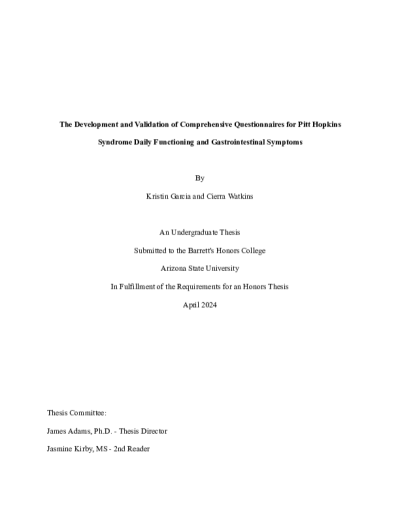Barrett, The Honors College Thesis/Creative Project Collection
Barrett, The Honors College at Arizona State University proudly showcases the work of undergraduate honors students by sharing this collection exclusively with the ASU community.
Barrett accepts high performing, academically engaged undergraduate students and works with them in collaboration with all of the other academic units at Arizona State University. All Barrett students complete a thesis or creative project which is an opportunity to explore an intellectual interest and produce an original piece of scholarly research. The thesis or creative project is supervised and defended in front of a faculty committee. Students are able to engage with professors who are nationally recognized in their fields and committed to working with honors students. Completing a Barrett thesis or creative project is an opportunity for undergraduate honors students to contribute to the ASU academic community in a meaningful way.
Filtering by
- Creators: School of Life Sciences
utritional therapy was beneficial, and future research on dietary treatments for autism and other disorders is recommended. This may also further discoveries of affected epigenomes with regards to nutritional treatments in disorders like ASD. The epigenome is the methylation and demethylation of the genome that mediates gene expression.
Sulfate deficiency is seen in children with autism through increased urinary excretion of sulfate and low plasma sulfate levels. Potential factors impacting reduced sulfation include phenosulfotransferase activity, sulfate availability, and the presence of the gut toxin p-cresol. Epsom salt baths, vitamin supplementation, and fecal microbiota transplant therapy are all potential treatments with promising results. Sulfate levels have potential for use as a diagnostic biomarker, allowing for earlier diagnosis and intervention.
The Healthy Pregnancy Summit is a collection of videos from a variety of specialists detailing how to have a healthy pregnancy and healthy child, based on the latest scientific and medical information. This project summarizes each presentation, and compares to the Healthy Child Guide, a document supplementary to the summit. Finally, this project analyzes the overall usefulness of the summit and each presentation, and suggests areas for improvement.
Methods: The Eye to Eye mentorship program assessed involved mentors and mentees who completed 12 in-person art sessions out of the normal 20 in-person sessions. The first main assessment was the BLD (Breger Learning Difference) Feedback Survey addressing one’s experience in the Eye to Eye program and which were completed at the end of the mentorship program and filled out by mentors, mentees, and mentees parents (one parent for each mentee). A total of 12 mentors, 6 mentees, and 6 mentee parents were included in the feedback survey final analysis. The second main assessments were the pre and post Behavior Assessment System for Child, Third Edition (BASC-3) provided to mentors, mentees, and mentees parents (one parent for each mentee). A total of 10 mentors, 5 mentees, and 5 mentee parents were included in pre and post BASC-3 final analysis. Fall 2019 (pre) and Spring 2020 (post) optional interviews involved 5 mentors and 3 mentees who showed interest and were comfortable participating with additional release forms.
Results: The program was generally positively rated in the feedback survey by mentors, mentees, and mentee parents. The highest responses for mentors, mentees, and mentee parents all incorporated average ratings of 4.0 or higher (out of 5.0) for perceived understanding of socio-emotional skills after Eye to Eye, experience in Eye to Eye, how having a mentor or mentee made them feel, and perceived change in self-awareness. All three groups reported fairly high ratings of improved self-awareness of 4.0/5.0 or above. No negative ratings were provided by any participants and the lowest response was no change. The BASC-3 evaluation found statistically significant improvement in mentors’ anxiety and atypicality and mentees’ sense of inadequacy.
Discussion: The Eye to Eye program was popular and well-rated despite only involving 12 in- person one-hour art sessions. The mentors, mentees, and mentee parents felt positive about the Eye to Eye program when answering the feedback survey. Some suggestions are made on how to improve this program to better enhance someone with learning differences future ability to succeed. Future research is needed to assess the true impact due to the COVID-19 epidemic and other limitations.


